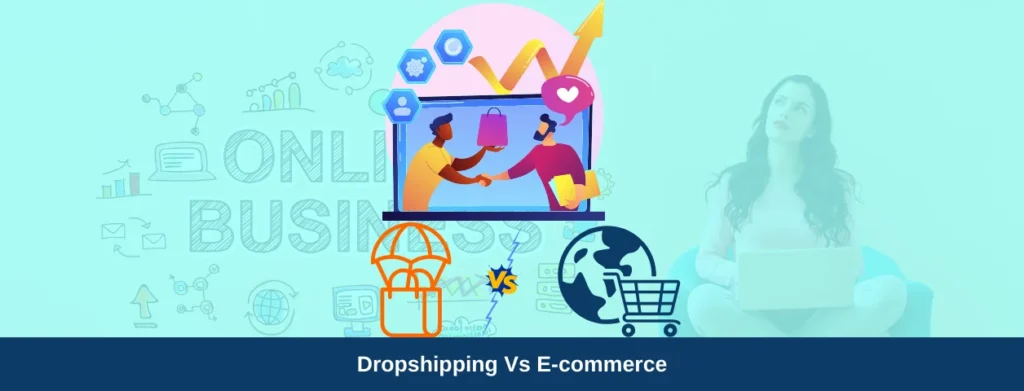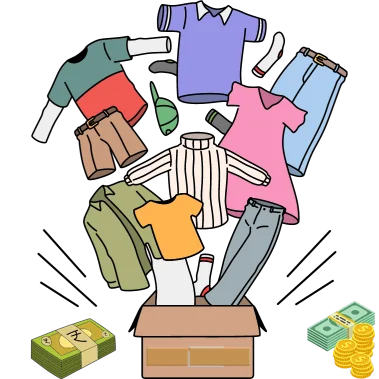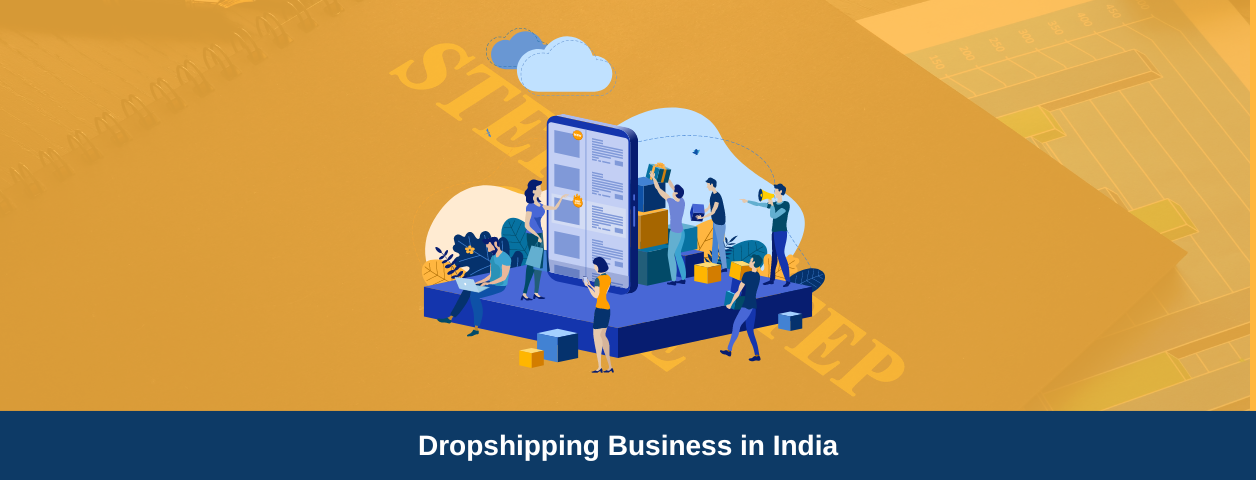If you’re looking to start your online store and are confused about whether to choose the eCommerce or dropshipping method, this guide is for you.
From understanding the basic differences between dropshipping and ecommerce to knowing which is the right platform for your business, I have covered everything in this guide.
Ecommerce Vs Dropshipping: the key differences
Here’s the key differences at a glance:
Feature | Reselling | Dropshipping |
Inventory Management | You manage inventory | Supplier manages the inventory |
| Upfront Investment | Higher | Lower |
| Control over Product | More control | Less control |
| Control over Shipping | More control | Less control |
| Profit Margins | Potentially higher | Potentially lower |
| Product Selection | More control over selection | Limited by supplier offerings |
| Manufacturing of products | Not necessary | Not required at all |
| Scalability | Scalable with proper inventory management | Scalable without inventory management burden |
| Risk | Dead stocks (Risk of unsold inventory) | Less risk of holding inventory |
| Branding | Easier to build your own brand | More challenging to differentiate |
What is dropshpipping?
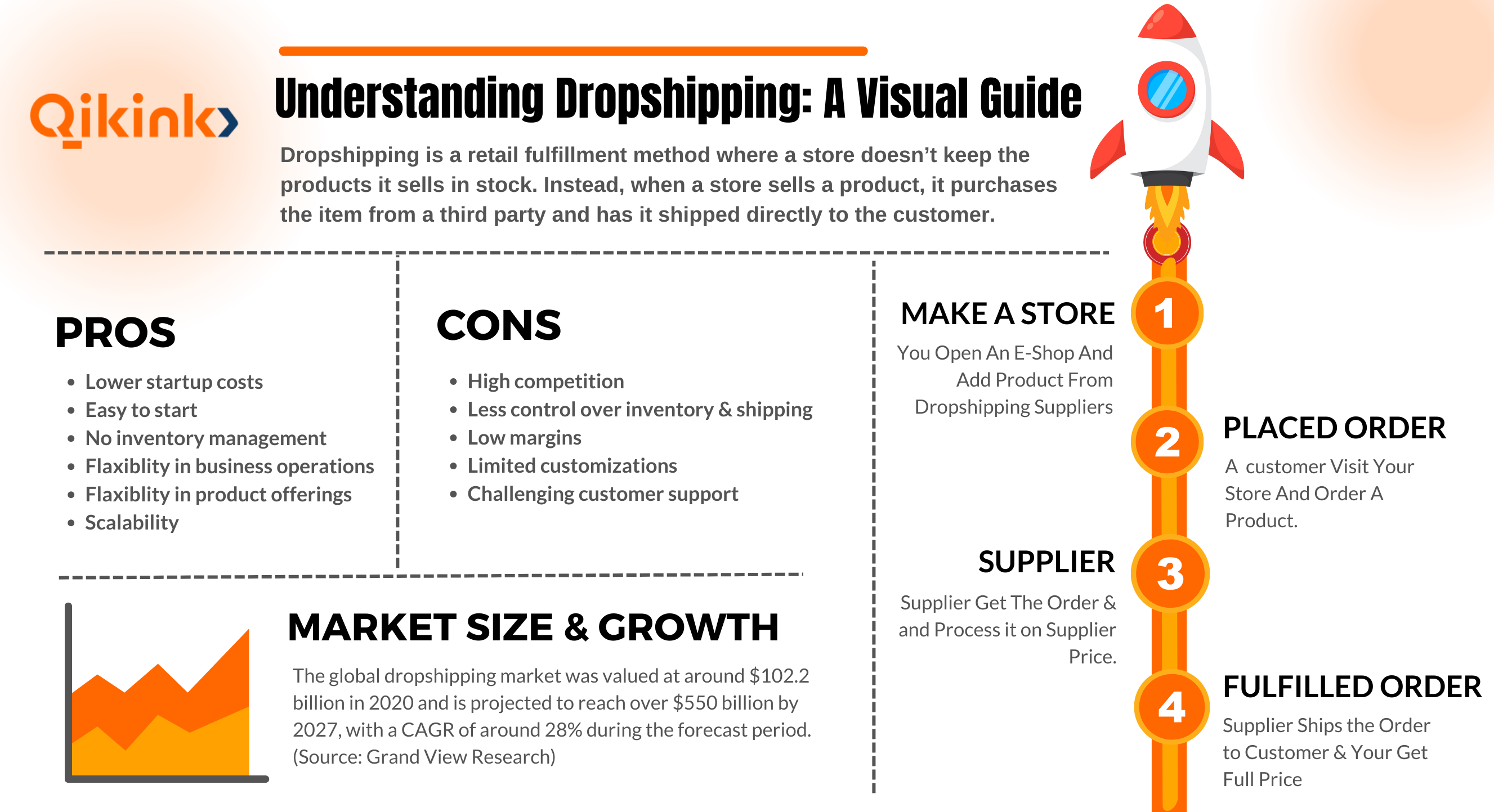
Dropshipping is a retail fulfilment method where a store sells products without owning or handling Inventory, packing, and shipping.
When a customer places an order, the merchant forwards the order to a third-party supplier who ships the product directly to the customer.
The merchant pays the supplier for the product at a discounted price, while keeping the difference as profit.
Dropshipping pros and cons
In this section, we will share the pros and cons of dropshipping for your better understanding of this business model.
Pros of Dropshipping:
1. Low Startup cost:
Low startup costs are one of the biggest advantages of dropshipping. You only pay for products when a customer orders them, so you don’t have to invest in inventory upfront. This means less risk if a product doesn’t sell.
2. Easier to experiment with different Products:
Experimenting with different products is easier with dropshipping. You can try out various items and market trends without committing to large bulk orders.
3. Easy to add new products:
Adding new products to your store is simple with dropshipping. There’s a wide range of products available, and you don’t need to keep them in stock or manage inventory. Many drop shippers offer diverse products, so with proper research, you can find the right fit for your store.
4. Location Independence:
You can run a dropshipping business from anywhere with an internet connection, giving you location independence.
5. Less manpower cost:
Dropshipping requires less manpower since you don’t need physical inventory.
6. There’s no hassle with order fulfillment and shipping:
Order fulfilment and shipping are hassle-free with dropshipping. When a customer places an order, the merchant forwards the order to a third-party supplier who ships the product directly to the customer.
Cons of Dropshipping:
1. Less Control:
You have less control over the quality, consistency, and delivery of your products.
2. Limited product Utilization:
While dropshipping offers a wide range of products, you’re limited to what your suppliers have in stock.
3. Low Profit Margin:
Since you’re purchasing products from a third party, you’re paying a higher price for each item. So your profit margins are lower than they would be with e-commerce.
4. Potential Issues:
Sometimes you deal with potential issues like order delays, Manual errors, or returns from customer orders.
5. Lack of control over the customer experience.
You have little control over the customer experience, which can be affected by factors like product quality, shipping times, and customer service.
6. Dropshipping has more competition.
Dropshipping faces stiff competition, as other sellers may offer the same products from the same drop shippers. Finding a unique selling point becomes crucial in this scenario.
What is Ecommerce?

Ecommerce, aka online shopping, is a form of electronic commerce which allows consumers to buy goods or services directly from a seller over the Internet using a web browser. It means store owners source or manufacture goods, keep inventory, and sell products directly to customers through online marketplaces.
E-commerce helps all kinds of businesses, from small shops to big companies, reach customers worldwide. It lets people shop easily from anywhere, anytime. And it helps businesses grow beyond just their local area, reaching more people around the globe.
The main steps of the Ecommerce business model are simple:
- The buyer goes to the website
- They find the product or service they want
- They add it to their cart
- They pay for it
- The products or services are delivered to them within a certain time
Basically, it’s about connecting people who want to buy things with people who want to sell things using the internet.
eCommerce pros and cons
In this section we will share the pros and cons of Ecommerce for your better understanding of this business model.
Pros of eCommerce
Control
E-commerce gives you full control over inventory, pricing, and shipping, making it easy to adapt your business as needed.
Personalization
You can create a personalized shopping experience for customers, offering custom packaging and thank-you notes.
Higher Profits
Buying inventory in bulk allows for the negotiation of lower prices from suppliers, resulting in higher profit margins per sale.
Large Market
With over 900 million internet users and increasing smartphone adoption, there’s a vast online market in India.
Easy Payment Options
Advanced payment collection tools like BHIM (Bharat Interface for Money), mobile wallets, and IMPS(Immediate Payment Service) make it simple to collect payments from customers.
Cons of eCommerce
High Initial Investment
E-commerce businesses may require a significant upfront investment to set up and establish.
Scalability Issues
Growing an e-commerce business can be challenging due to scalability issues, such as managing increased demand and expanding operations.
Inventory and Market Trends Risk
E-commerce businesses face risks related to inventory management and staying updated with market trends to meet customer demands.
Manual Labor
Running an e-commerce business may require manual labour for tasks like product listing, order processing, and customer service.
Shipping Challenges
Timely and reliable shipping is essential in e-commerce, but challenges like delays and high shipping costs can impact customer satisfaction.
Choose our on-demand Unisex clothing products
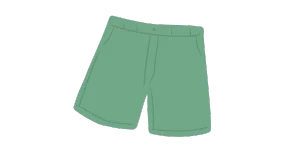
Dropshipping examples
Here’s a detailed rundown of the top dropshipping website examples for your better understanding.
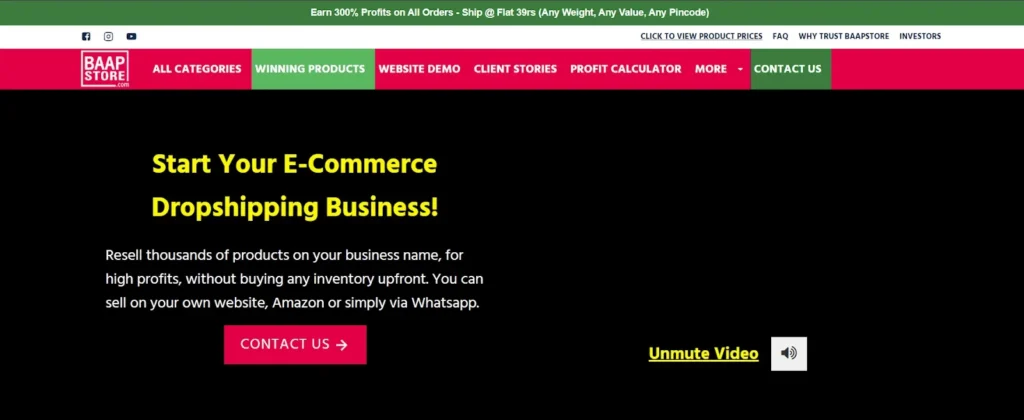
BaapStore is a comprehensive dropshipping platform that offers an all-in-one solution. Baapstore provides you with complete end-to-end dropshipping services.
It helps you to start an online e-commerce business providing you with everything you need, at one cost. These include features like inventory management, order tracking, Return management and marketing tools.
Products They Sell:
- Apparel products
- Footwear
- Kids Toys
- Photo Frames
- Home & Kitchen Products
- Mobile & Electronic Accessories
How Baapstore became successful:
Baapstore’s success lies in its unique approach to dropshipping, offering products at wholesale rates while granting sellers complete freedom to set their own selling prices.
Unlike other platforms, Baapstore imposes no restrictions or benchmarks on pricing, making it incredibly versatile and attractive to sellers.
This flexibility has played a significant role in Baapstore’s success, allowing sellers to maximize their profits and tailor their pricing strategies to their specific market and audience.
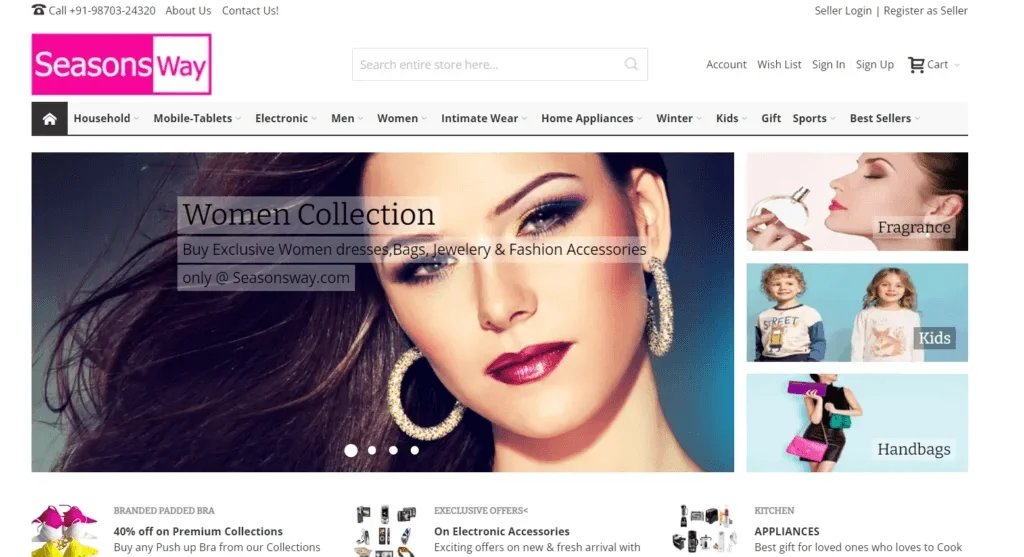
Seasonway is also a marketplace in India that lets you benefit from its pre existing customer base. They do take care of order fulfillment and customer service. While a free seller account exists, premium plans with enhanced features are also available.
Products They Sell:
- HouseHold products
- Mobile Accessories
- Electronic accessories
- Apparel Products
- Sports products
- Home Appliances
How Seasonsway became successful:
Seasonsway.com achieved success by simplifying product discovery, consolidating 150,000 items from various suppliers into a single catalogue.
This unified catalogue seamlessly integrates with major shopping cart providers, enhancing the shopping experience for customers.
Seasonsway’s success is further propelled by its commitment to helping businesses grow through robust automation and tailored tools crafted to meet their specific requirements.
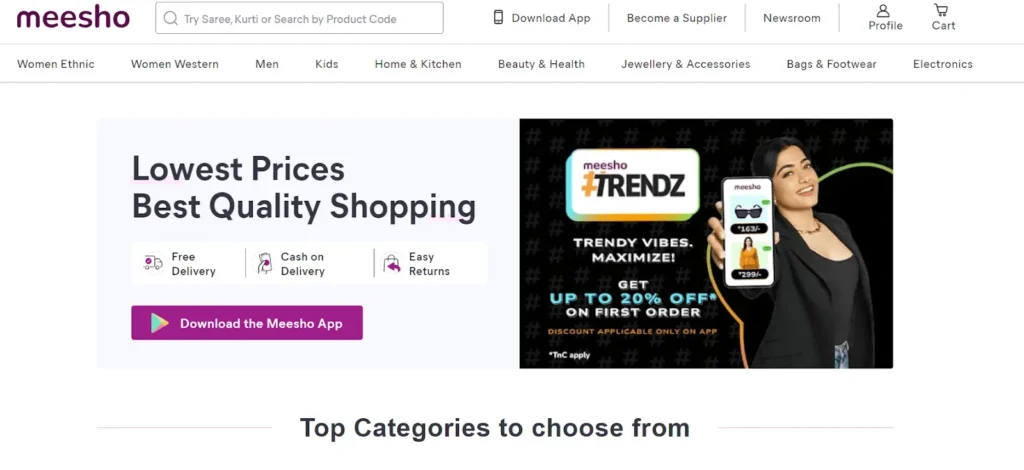
Currently, it is the third most used e-commerce platform in India after Amazon and Flipkart. And needless to say, they have a huge customer base. With Meesho, you can share and sell a wide range of products from various suppliers directly through your social networks, like WhatsApp and Instagram. Meesho is entirely free to use, but you’ll earn commissions on successful sales you make only through the platform.
Products They Sell:
- Apparel Products
- Home & Kitchen Products
- Beauty & Health products
- Jewellery & Accessories
- Bags & Footwear Products
- Electronic Products
How Meesho became successful:
Meesho became successful because it’s different from other online stores. It’s more like a social media platform for selling things.
Meesho connects people who want to sell stuff with the companies that make those products. People can then sell these products on their own social media pages.
What’s special about Meesho is that users can earn money by selling products from these companies and making a profit. This has helped many people start their own businesses and made Meesho very popular.
👉Recommended resource: What is Dropshipping Business in India & How it Works?
Ecommerce business examples
Here’s a detailed rundown of the top eCommerce website examples for your better understanding.
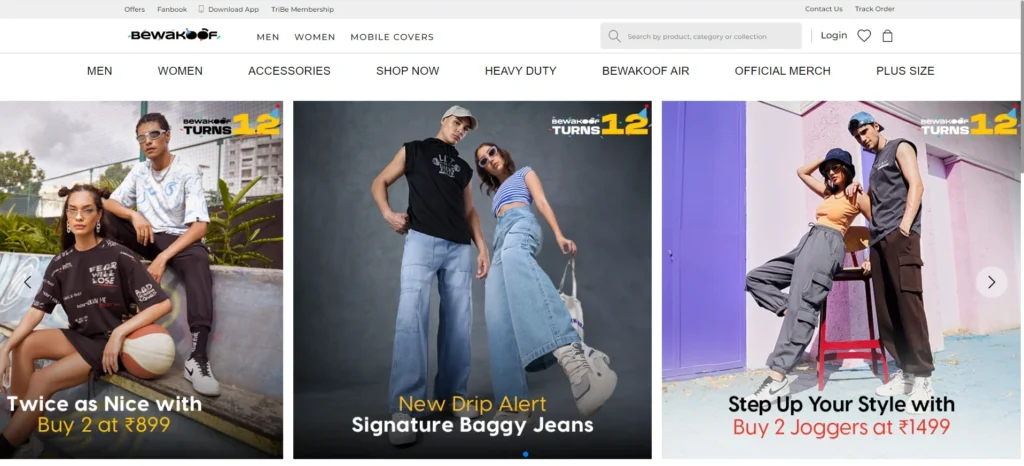
Bewakoof is a lifestyle fashion brand that makes creative, distinctive fashion for the trendy, contemporary Indian. They are vertically integrated, and They manufacture their own products.
They are selling products directly to the customer(direct-to-consumer model). They are handling all fulfilment processes from receiving orders to shipping.
Products They Sell:
- Apparel products
- Footwear products
- Accessories
- Mobile Covers
- Winter wears
How Bewakoof became successful:
Bewakoof became a hit with its unique quirky designs, vibrant apparel, and unique marketing strategies.
Their direct-to-consumer model brings accessibility and value to everyday fashion. They try to target all kinds of customers and cater to their needs and preferences. With every new design and ad, Bewakoof shows they’re all about celebrating each person’s unique vibe.
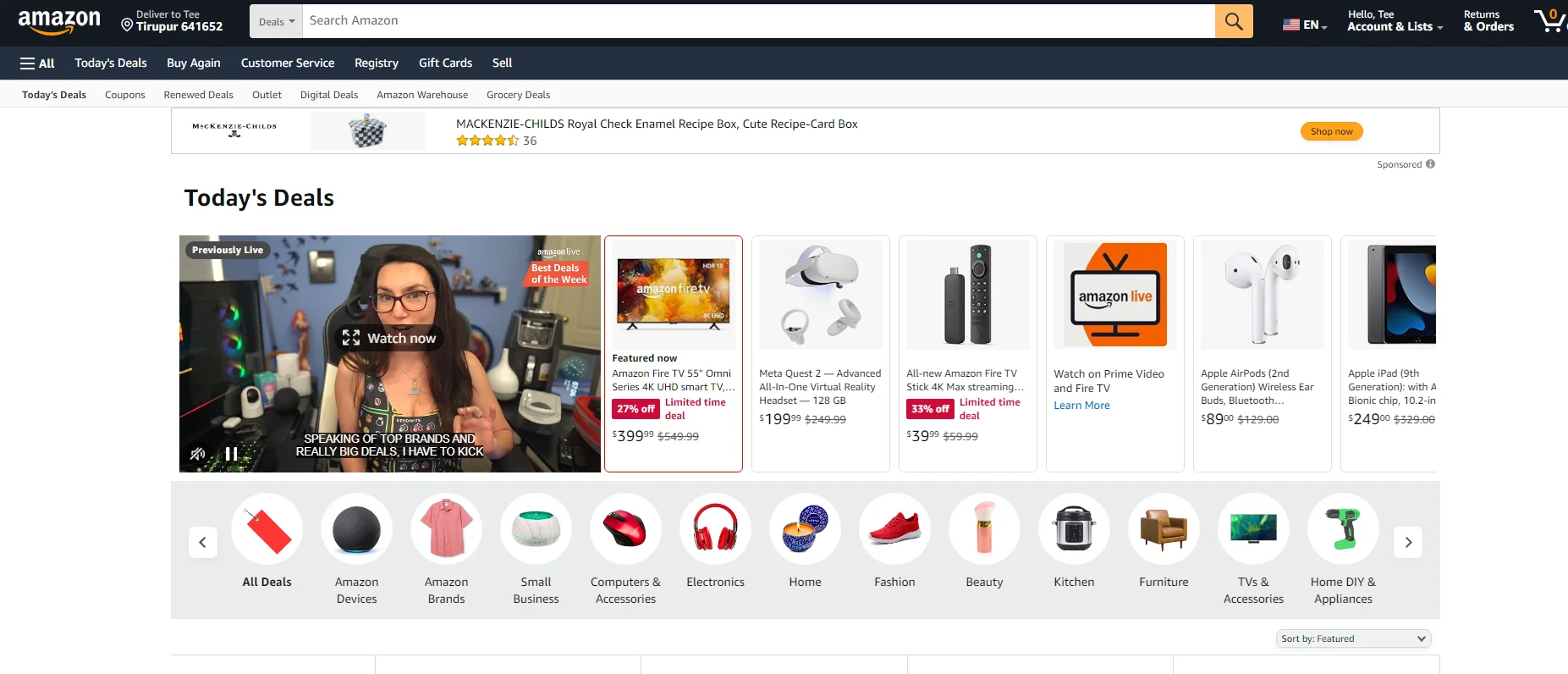
Amazon is a popular online shopping platform that offers a wide variety of products from both its own inventory and from third-party sellers.
The Amazon Marketplace is an e-commerce platform operated by Amazon that allows third-party sellers to list and sell their products alongside Amazon’s own retail offerings. It’s a way for individuals, businesses, and brands to reach a vast online customer base.
Overall, the Amazon Marketplace provides a platform for sellers to reach a wide audience and sell products efficiently, leveraging Amazon’s infrastructure and customer base.
How the Amazon Marketplace works:
- Seller Registration: Individuals or businesses can sign up as third-party sellers on Amazon.
- Product Listing: Sellers can create listings for their products, providing details like price, condition, and shipping choices.
- Customer Orders: When a customer buys a product from a third-party seller, the seller is responsible for fulfilling the order. This includes shipping the item, handling customer queries, and managing returns.
- Fulfilment Options: Sellers can fulfil orders themselves (FBM – Fulfillment by Merchant) or use Amazon’s fulfilment services (FBA – Fulfillment by Amazon), where Amazon handles storage, packing, and shipping.
- Payment: Amazon processes customer payments and transfers the proceeds, minus fees, to the seller’s account.
- Ratings and Reviews: Sellers are rated and reviewed by customers, impacting their reputation on the platform.
Products They Sell:
- Clothing Apparel products
- Computer & Accessories
- Digital content and devices
- Electronic products
- Home and living accessories
- Fashion and Beauty products
- Furniture and kitchen appliances
How Amazon became successful:
Amazon’s success stems from its, Focus on customer satisfaction like Prioritizing user-friendly interfaces, fast delivery, and features like product reviews and easy returns. Offering a wide array of items, including third-party sellers’ products, making it a go-to destination for shoppers. Maintaining attractive prices through strategies like volume discounts and dynamic pricing.
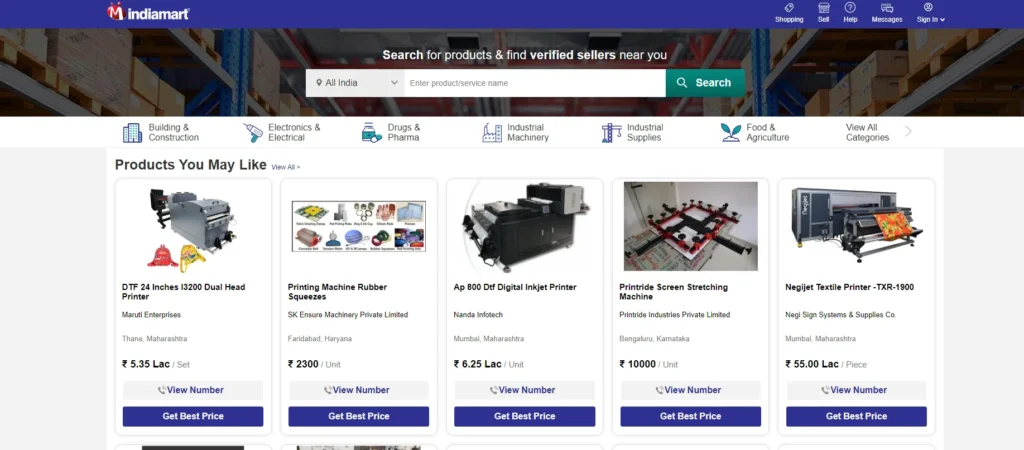
You can call this a giant in India’s B2B marketplace. IndiaMART is a great platform for connecting buyers with sellers across various products. They have 187 Million Buyers, 7.8 Million Suppliers, 104 Million Products & Services.
It is a great option if you are looking to source products from Indian manufacturers and wholesalers. However, keep in mind that integration options are limited compared to platforms like Shopify, making it difficult to run a purely online dropshipping business.
Products They Sell:
- Apparel Items
- Footwear
- Beauty products
- Pet supplies
- Accessories and Home decor
How IndiaMart became successful:
IndiaMART’s success as a B2B marketplace giant stems from being an early mover in the industry and building an extensive network of millions of buyers and suppliers. Its user-friendly platform, coupled with value-added services and continuous innovation, has earned trust and credibility among users. Additionally, IndiaMART’s expansion into global markets has further fueled its growth and success.
Dropshipping business ideas

Starting your own business is exciting and fulfilling, but figuring out how to begin can be tough. Dropshipping is a great option for beginners because it doesn’t need much investment and lets you sell products without storing inventory.
We’ve compiled a list of top dropshipping business ideas focusing on high profitability and Products to sell online.
- Polo t-shirts
- Gym vest
- Crop tops
- Tote bags
- Coffee mugs
- Phone cases
- Mouse pad
- Sweatshirts
- Unisex Joggers
- Sports bra
- Framed Posters
👉 Check out our guide we have created this list of 13 best dropshipping business ideas backed with data (considering high profitability, and low-med competitiveness). Also, we have included a bunch of metrics for each business idea.
eCommerce business ideas
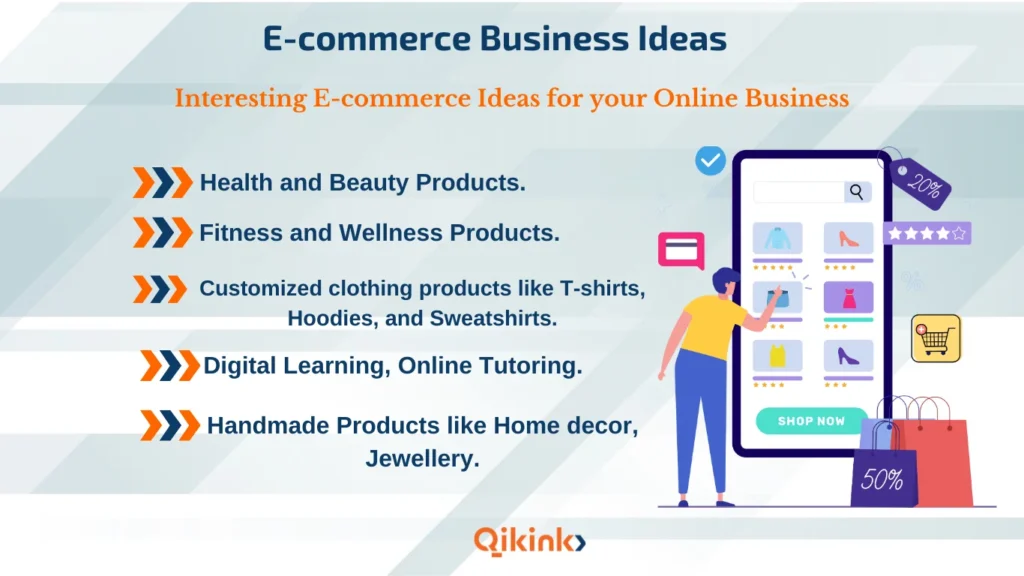
The e-commerce industry is growing fast, giving entrepreneurs lots of chances to start successful online businesses.
It’s exciting to think about starting a new business and a website, but figuring out how to start might be confusing. This could include selling products directly to consumers (B2C), selling to other businesses (B2B), or a combination of both.
It becomes easy to launch your very own ecommerce business when you have some interesting ideas. Here we share some Interesting E-commerce profitable business ideas.
- Health and beauty products: Sell popular health and beauty items online, like vegan or cruelty-free products, for a growing market.
- Digital Learning & Online Tutoring: Start an online education platform to meet the increasing demand for web-based learning. Provide online tutoring services for various subjects like math or science to meet the growing demand for virtual learning.
- Publishing ebooks: Self-publish ebooks on platforms like Amazon Kindle to reach a wide audience.
- Selling personalized art: Create and sell custom artwork online, catering to the growing demand for unique pieces.
- Reuse and recycle: Start an online store selling used items to meet the demand for sustainable shopping options.
- Smart home products: Capitalize on the growing smart home market by selling innovative home automation products.
- Subscription boxes: Curate monthly subscription boxes filled with niche products like beauty items or snacks for convenience-loving customers.
- Customized products: Sell personalized items like clothing or home decor to meet specific customer preferences.
- Dropshipping: Start an online store without keeping inventory by acting as a middleman between customers and suppliers.
- Handmade products: Offer handmade goods such as jewellery or home decor for customers seeking unique and personal gifts.
- Fitness and wellness products: Provide fitness equipment, Sell dietary supplements to cater to the health and fitness market, or healthy meal options for health-conscious consumers.
- Pet products: Cater to pet owners by selling a variety of products like pet food, toys, or accessories for their furry companions.
Dropshipping vs Ecommerce: Which is more profitable?
E-commerce businesses often buy products in bulk, allowing for lower prices and higher markups, resulting in greater profit margins. With control over pricing and inventory, they can capitalize on economies of scale.
Dropshipping, on the other hand, doesn’t require holding inventory but can lead to lower profit margins due to higher unit prices and price competition among sellers. Suppliers may also raise prices to cover shipping costs.
While initial costs are low, tasks like inventory management and shipping impact profitability.
Overall, e-commerce typically offers higher profit margins, averaging over 40%, compared to the 15%-20% range for dropshipping.
How much upfront investment is required in dropshipping and eCommerce?
Dropshipping requires minimal upfront investment as there’s no need to purchase inventory, warehouse space, or packaging materials. Instead, you’ll need to allocate funds for setting up an online store, marketing, and potentially subscribing to dropshipping platforms.
In contrast, traditional e-commerce businesses typically require a higher initial investment. This includes purchasing inventory, renting storage space, investing in packaging, and setting up an online store. Additionally, there may be costs for marketing, website development, and staff hiring.
Overall, dropshipping offers lower upfront costs, while traditional e-commerce requires more investment in inventory and infrastructure. To start a dropshipping business in India, you’ll typically need a small initial investment ranging from ₹8,000 to ₹10,000. On the other hand, starting an e-commerce business requires a higher initial investment, typically ranging from ₹85,000 to ₹1 lakh.
Dropshipping and Ecommerce: Which one is easier to start?
Starting a dropshipping business is easier compared to e-commerce for several reasons. With dropshipping, there’s a low initial investment since you don’t need to purchase inventory, rent storage space, or invest in packaging equipment. In contrast, e-commerce businesses require significant upfront capital for inventory, warehousing, and logistics.
Dropshipping also offers more scalability as you can expand your business without worrying about inventory management or warehouse space. In e-commerce, managing increased demand and expanding operations can be challenging due to scalability issues.
Additionally, dropshipping reduces the risk of inventory and market trends. With e-commerce, businesses face risks associated with inventory management and staying updated with market trends to meet customer demands.
Moreover, dropshipping requires less manual labour as tasks like order fulfillment and shipping are handled by suppliers. E-commerce businesses, on the other hand, may require manual labour for product listing, order processing, and customer service.
Lastly, dropshipping allows for a wider range of products without inventory concerns. You can easily try out different products to find your best sellers and update your catalogue to keep up with market trends. In contrast, e-commerce businesses may face challenges with inventory management and staying updated with market trends.
Dropshipping and Ecommerce
Picking the right market is super important for any business. It affects what you sell, how you price things, how you advertise, and even how you run your whole business.
When you’re thinking about whether to go for dropshipping or e-commerce, you need to understand what each one is good at. Dropshipping is all about selling stuff that other companies make, so it’s great for selling things that are cheap and easy to find. On the other hand, eCommerce means you’re selling things that you own or make yourself, so you can target a wider range of customers.
Deciding between dropshipping and ecommerce depends on what you want and what you’re comfortable with. If you want a low-cost way to sell lots of different things without taking too much risk, dropshipping might be for you. But if you’re okay with investing more money upfront to have more control over what you sell, then ecommerce could be the way to go. It’s all about figuring out what works best for your business goals and the audience you want to sell to.
What are the platforms to start your Dropshipping and Ecommerce business?
Platforms to start your E-Commerce business:
When starting an online store or business, it’s important to choose the right platform. With so many choices available, it can feel overwhelming.
However, after looking into it, we’ve found that setting up your own website using platforms like WooCommerce, Shopify, or Dukaan, or selling on big sites like Amazon or Flipkart are the best options for new businesses.
Here are some key steps to start an ecommerce online business:
Starting an ecommerce business is exciting but requires planning. Here are the key steps:
- Choose a Product: Pick something you’re passionate about and research what’s in demand
- Know Your Audience: Define who you’re selling to based on their interests and habits.
- Build an e-commerce Website: Use platforms like Shopify or WooCommerce to create your site.
- Set Up Payments: Use services like PayPal or Stripe or the best payment gateways to receive payments.
- Market Your Business: Use SEO, social media, and email to attract customers.
- Fulfill Orders: Ship products yourself or use a logistics provider.
- Track Performance: Use tools like Google Analytics to see how your business is doing and make improvements.
Platforms to start your dropshipping business:
Starting a dropshipping business is easy but you need to have a plan for it. Starting a dropshipping business involves several key steps:
- Choose a profitable Niche: Pick a niche you’re passionate about and ensure there’s demand for the products.
- Market Research: Understand your target audience, competitors, and market trends.
- Create a Business Plan: Outline your goals, strategies, and financial projections.
- Find Reliable Suppliers: Research and select trustworthy suppliers for your products.
- Choose the Right E-commerce Platform: Select a platform like Shopify or WooCommerce for your online store.
- Set Up Your Online Store: Customize your store’s design, add products, and integrate payment gateways.
- Develop a Marketing Strategy: Use SEO, social media, and email marketing to promote your products.
👉 Launch your online business using Qikink dropshipping services. Qikink also provides seamless integration services with WooCommerce and Shopify to run your dropshipping ecommerce business smoother.
👉 Here’s why you should look for a reliable dropshipping platform like Qikink:
- We not only have a huge variety to choose from, but they also dispatch orders within 2-3 working days.
- We ship worldwide and deliver your product within 12 working days.
- Unlike other suppliers, there is no minimum order number for our personalized print on demand products.
- With our e-commerce integration, you can scale your POD business to the next level.
- At Qikink, we provide free custom branding with your logo on every courier.
- Our delivery and inventory management service allows you to provide COD options to your customers— which helps you increase your conversion rate and build trust.
👌 Working with Qikink is hassle-free, too.
How to combine eCommerce and dropshipping together?
Qikink offers a hybrid model (ecommerce + dropshipping)that seamlessly combines eCommerce and dropshipping.
Here’s a straightforward explanation for better understanding.
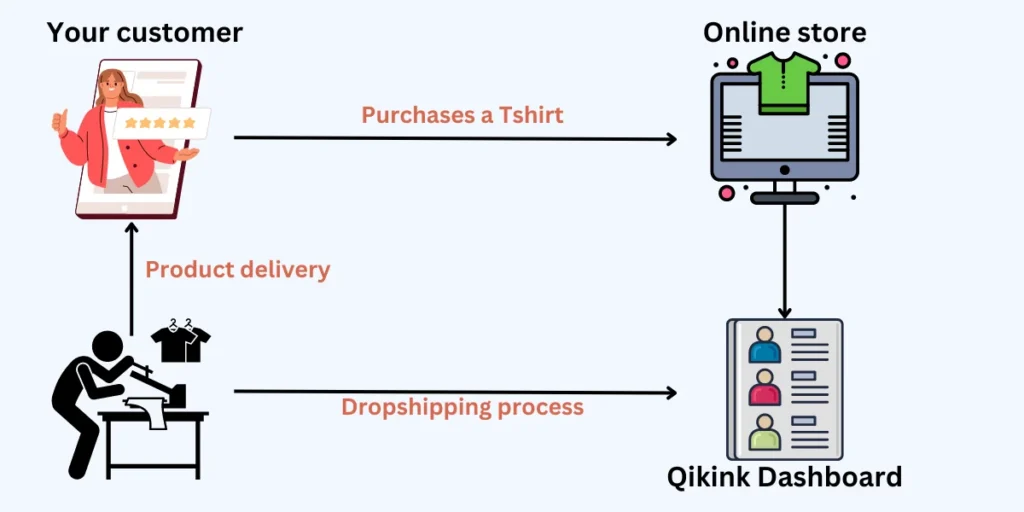
1. Qikink helps you in inventory Management
E-commerce: You’re in charge of managing inventory levels and storage space. This means you can control how much stock you have on hand and where it’s stored.
Dropshipping: Suppliers take care of inventory management, eliminating the need for you to store products.
Qikink: Here is how Qikink helps in inventory management.
- On-demand printing
Qikink prints products only when you receive an order, eliminating the need to maintain inventory.
- Real-time inventory tracking
Qikink provides a low-stock and no-stock report, which helps you plan your product promotion. It also auto-syncs inventory if your Shopify store is integrated with Qikink’s platform.
- Inventory replenishment
Qikink monitors stock levels and manufacturing capacity to ensure orders are filled immediately. We monitor product demand and refill inventory accordingly, reducing the likelihood of stockouts or fulfilment delays.
2. No upfront Investment is required when you start your online business with Qikink

E-commerce: Requires a higher initial investment since you’re buying inventory in bulk upfront.
Dropshipping: This involves a lower upfront investment as you only pay for products when customers place orders.
Qikink: You don’t need to keep an eye on inventory and upfront costs to set up the store. Qikink is free to use for a lifetime. You only pay us when you place an order.
3. Get control over your product
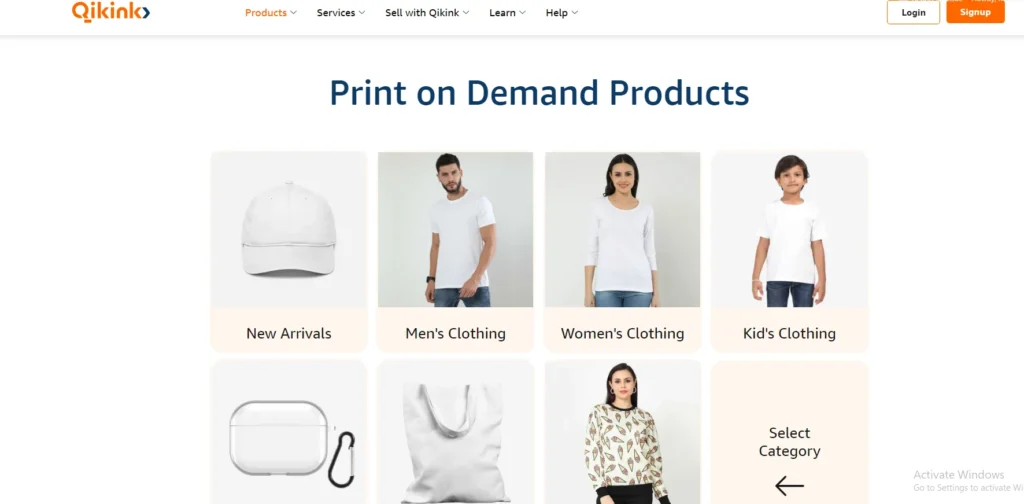
E-commerce: Gives you full control over product selection and quality.
Dropshipping: Offers less control over product selection and quality since you’re reliant on suppliers.
Qikink: Choose your product from India’s largest print-on-demand catalogue. You can still choose products that your customers will love.
4. Get control over shipping and delivery
E-commerce: Provides greater control over shipping methods, packaging, and delivery times.
Dropshipping: Gives you less control over shipping logistics, as suppliers handle order fulfilment and delivery.
Qikink: With Qikink, you have control over shipping. They custom print orders with your branding and ship directly to your customers. Qikink partners with top courier companies like FedEx, DHL, and Aramax for fast and reliable international shipments. Tracking IDs are provided for easy monitoring through the Qikink dashboard. Qikink handles shipping, ensuring smooth delivery.
5. Qikinke helps you maximize the profit Margins
E-commerce: Offers potentially higher profit margins since you can set your own prices and negotiate bulk discounts with suppliers
Dropshipping: May result in lower profit margins due to the higher costs associated with sourcing products from suppliers.
Qikink: For online businesses like dropshipping and Print on Demand, aiming for a profit margin between 15% to 35% is ideal. Qikink offers competitive pricing, allowing you to set favourable prices and earn good margins. Plus, they provide free branding with your logo on shipments, along with quality customization tools and services, ensuring high(95%) customer satisfaction.
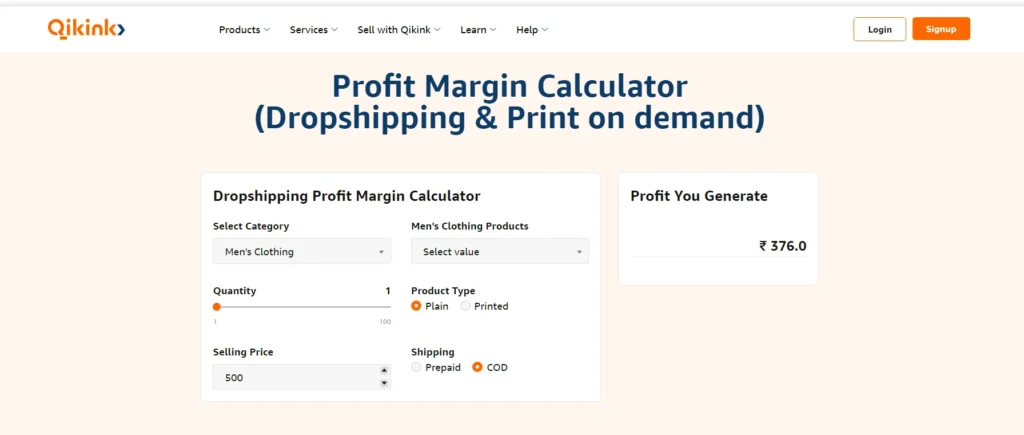
For Example: Let’s say you sell a t-shirt through your dropshipping store for ₹500. You pay your supplier ₹200 for the t-shirt.
So by putting the formula into use, your profit margin will be
Profit Margin = ((₹500 – ₹200) / ₹500) x 100% = 60%
In this example, your profit margin is 60%. This means for every ₹500 sale, you make a profit of ₹300.
👉 Calculate your profit margin using Qikink’s calculator :
6. Choose from hundreds of product with Qikink
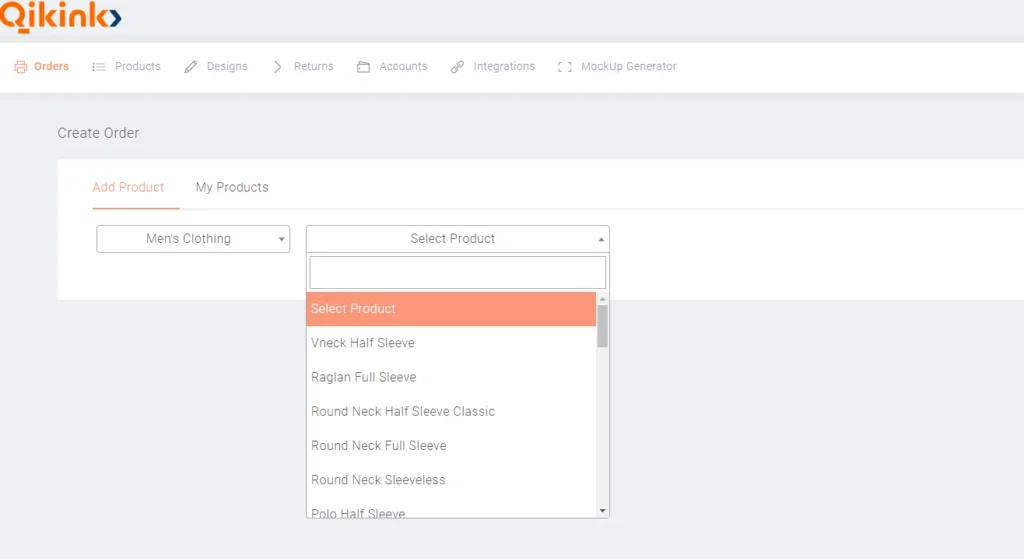
E-commerce: Allows for a wide range of product options and customization possibilities.
Dropshipping: Limits product selection to items available from suppliers.
Qikink: Qikink offers the Largest products ranging from apparel to Accessories in India for Print on Demand and Dropshipping. Choose your product from India’s largest print-on-demand catalogue. You can still select products that your customers will love.
7. Less risky
E-commerce: Involves the risk of holding unsold inventory, which can tie up capital and lead to financial losses.
Dropshipping: Minimizes the risk of holding inventory, as you only purchase products once orders are received.
Qikink: With Qikink, you can create and sell custom products without having to keep inventory.
This means you don’t have to pay upfront for large quantities of products or worry about the costs of storing and shipping them. This makes a low-risk business model.
👉check out Custom branding service
8. Customer service
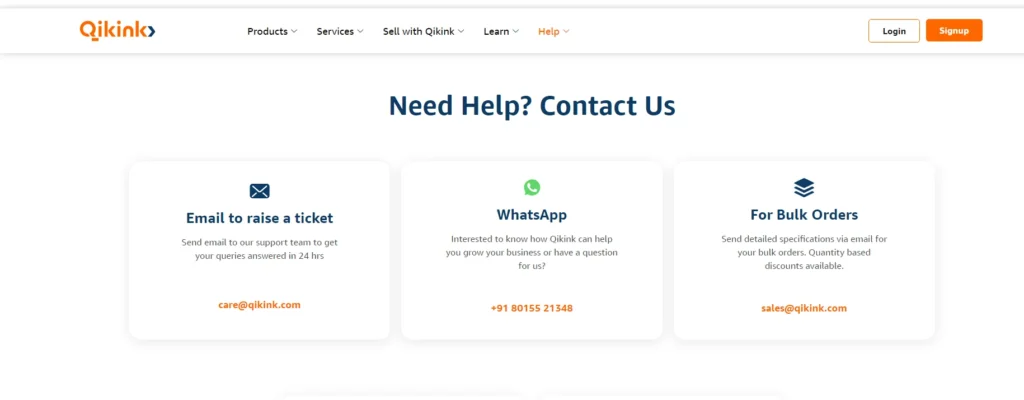
E-commerce: More Comprehensive Customer Experience
Dropshipping: Limited experience in customer service.
Qikink: Qikink has a dedicated customer support team to address customer queries, providing with comprehensive answers to frequently asked questions tailored to your needs. We offer a wealth of information, covering both basic and advanced topics, to support you in starting your dropshipping business.
End Note:
Qikink’s hybrid model effectively combines dropshipping and e-commerce, offering entrepreneurs the benefits of both.
With Qikink’s seamless integration, starting a profitable online business becomes more accessible, providing flexibility and convenience to meet various business needs.

